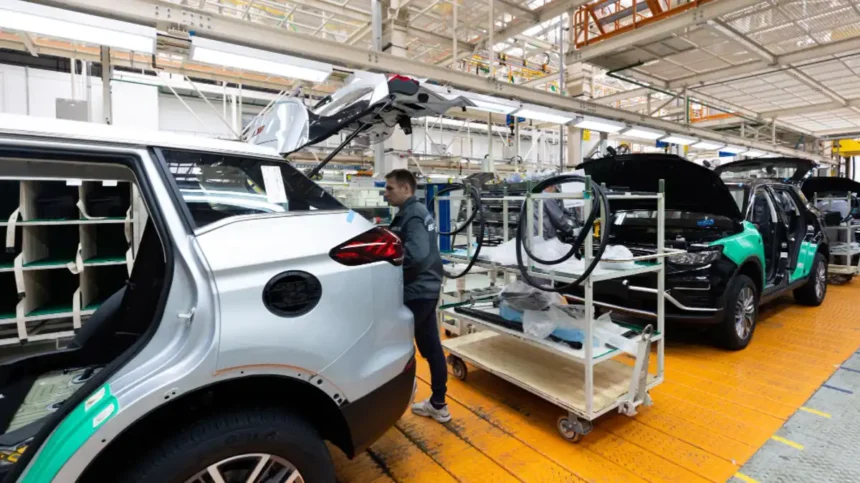Have you ever wondered how the latest technology influences the cars we drive and the way we experience travel? With the rise of 5G technology, the automotive industry is undergoing a transformative shift that promises to redefine connectivity, safety, and the overall driving experience. As we stand on the brink of this automotive revolution, it’s essential to explore the impact of 5G on the automotive industry and understand its potential to reshape our future.
In this article, we’ll dive deep into how 5G is influencing car tech, enhancing safety features, enabling autonomous driving, and providing a seamless connectivity experience. Buckle up as we embark on this insightful journey into the world of 5G and its monumental effects on the automotive landscape!
What is 5G and Why is it Important for the Automotive Industry?
5G, the fifth generation of mobile network technology, is designed to provide faster speeds, lower latency, and greater capacity than its predecessors. For the automotive industry, this translates into a new era of vehicle communication, connectivity, and intelligence. Here’s why 5G is pivotal:
- Speed and Efficiency: 5G networks can deliver data at incredibly high speeds, enabling real-time communication between vehicles and infrastructure.
- Low Latency: The ultra-low latency of 5G (as low as 1 millisecond) is crucial for applications requiring immediate feedback, such as autonomous driving.
- Increased Capacity: 5G can support a massive number of connected devices, essential for smart cities and vehicle-to-everything (V2X) communication.
How 5G is Transforming Car Tech in the Automotive Industry

1. Enhanced Connectivity
One of the most significant impacts of 5G on the automotive industry is enhanced connectivity. Cars equipped with 5G technology can communicate with other vehicles, infrastructure, and even the cloud. This connectivity allows for:
- Vehicle-to-Vehicle (V2V) Communication: Cars can share information about road conditions, traffic signals, and hazards in real time, improving safety.
- Vehicle-to-Infrastructure (V2I) Communication: Vehicles can interact with traffic lights and signs, optimizing traffic flow and reducing congestion.
- Vehicle-to-Pedestrian (V2P) Communication: This feature alerts drivers about nearby pedestrians and cyclists, enhancing road safety.
| Communication Type | Description | Benefits |
|---|---|---|
| V2V | Vehicles sharing information with each other | Improved safety and reduced accidents |
| V2I | Vehicles communicating with infrastructure | Optimized traffic flow and efficiency |
| V2P | Vehicles alerting pedestrians and cyclists | Enhanced safety for vulnerable users |
2. Advancements in Autonomous Driving
The automotive industry is rapidly moving toward autonomous vehicles, and 5G plays a crucial role in this evolution. Here’s how:
- Real-Time Data Processing: With 5G, vehicles can process vast amounts of data from sensors and cameras in real time, making quick decisions necessary for safe driving.
- Remote Control Features: 5G enables remote control capabilities, allowing users to manage their vehicles from a distance. This is particularly useful for parking or navigating through tight spaces.
- Enhanced Sensor Integration: 5G allows for better integration of sensors, enhancing a vehicle’s perception of its environment.
3. Improved In-Car Experience
5G technology enhances the in-car experience for passengers by offering:
- High-Speed Internet Connectivity: Passengers can enjoy high-speed internet for streaming, gaming, and browsing while on the road.
- Real-Time Navigation: With faster data access, navigation systems can provide real-time updates on traffic and route optimization.
- Advanced Infotainment Systems: 5G allows for more advanced infotainment options, including cloud-based services and applications.
4. Safety and Security Enhancements
Safety is a paramount concern in the automotive industry, and 5G significantly improves safety measures:
- Predictive Maintenance: Vehicles can transmit data about their health, allowing for predictive maintenance and reducing the likelihood of breakdowns.
- Emergency Response: In the event of an accident, 5G enables vehicles to automatically contact emergency services, providing location and accident details.
- Cybersecurity Measures: With enhanced connectivity comes the need for robust cybersecurity. 5G can support advanced security protocols to protect vehicles from cyber threats.
Challenges of Implementing 5G in the Automotive Industry
While the impact of 5G on the automotive industry is largely positive, there are challenges to consider:
1. Infrastructure Development
The widespread adoption of 5G requires significant investment in infrastructure, including the installation of new cell towers and networks. This can be a complex and time-consuming process.
2. Data Privacy Concerns
With increased connectivity comes heightened concerns over data privacy. Ensuring that user data is protected and not misused is a priority for automakers and regulatory bodies.
3. Cost Implications
Implementing 5G technology in vehicles may increase costs for manufacturers, which could be passed on to consumers. Balancing affordability and advanced technology is crucial.
Future of 5G in the Automotive Industry
1. Smart Cities and Autonomous Vehicles
The integration of 5G technology with smart cities will create an ecosystem where vehicles, infrastructure, and services are interconnected. This will pave the way for fully autonomous vehicles operating in real-time traffic conditions.
2. Enhanced User Experience
As 5G technology evolves, the user experience in vehicles will continue to improve. Expect personalized infotainment systems, seamless navigation, and enhanced connectivity with smart devices.
3. Collaboration Between Industries
The automotive industry will increasingly collaborate with telecommunications and tech companies to leverage 5G advancements. This collaboration will lead to innovative solutions that enhance safety, connectivity, and efficiency.
Frequently Asked Questions (FAQs)
Q1: How does 5G improve vehicle safety?
A: 5G enhances vehicle safety by enabling real-time communication between vehicles and infrastructure, allowing for quicker reactions to potential hazards.
Q2: Will all cars have 5G capability?
A: While many new vehicles will come equipped with 5G technology, retrofitting older models may not be feasible. Over time, however, 5G is expected to become standard in most vehicles.
Q3: How will 5G affect the cost of vehicles?
A: The integration of 5G technology may initially increase manufacturing costs, but as technology becomes more widespread and affordable, prices are likely to stabilize.
Q4: What are the cybersecurity implications of 5G in cars?
A: Increased connectivity raises concerns about potential cyber threats. Manufacturers must implement robust security measures to protect against hacking and data breaches.
Q5: When can we expect widespread 5G adoption in the automotive industry?
A: Widespread adoption of 5G in the automotive industry is already underway, with ongoing advancements expected over the next several years. Complete integration will depend on infrastructure development and regulatory approval.
Conclusion
The impact of 5G on the automotive industry is profound, ushering in a new era of connectivity, safety, and innovation. As car tech continues to evolve, 5G will be at the forefront, transforming how we interact with our vehicles and the world around us. Embracing this technology promises to enhance our driving experience, making it safer, more efficient, and more enjoyable than ever before. The future of the automotive industry is bright, and 5G is leading the way!








